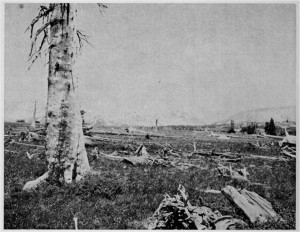
In the fall of 1997, I helped Bill Reiners teach a seminar at the University of Wyoming for about 15 graduate and undergraduate students. Our goal was to learn something about the ecology of a high plateau in the Medicine Bow Mountains which is about an hour from campus. Libby Flats is near treeline at an elevation of about 9500 feet, and is scattered with hundreds of large, dead trees, mostly fallen but some still standing. At several places on the plateau, stands of living Engelmann spruce had ordered themselves into ribbon forests, with parallel rows of trees separated by mostly treeless alpine vegetation. In 1969, Dwight Billings published a paper in Vegetatio about Libby Flats, and there was still some interest in learning more about the dramatic patterns of living and dead trees there.

“…We cut down one of these living trees to date the fire. Instead of only one fire, there were two fires; both pre-date the coming of European man. One occurred in 1766 and was probably a ground fire; the second fire in 1809 was apparently a severe crown fire and destroyed most of the forest. After almost 160 years, the dead trees and logs still remain.”

On September 13, 1997, two students and I found the large dead spruce in Billings’ photograph. We repeated the photo (with the first digital camera I ever used), and took two increment cores of the still solid trunk. We also stumbled upon the cut stump of the live scarred tree that Billings had felled 30 years earlier. The trunk was on the ground where it had fallen, and the stump was solid enough to collect a new section from it on a later visit. I used these samples in the seminar to demonstrate some of the common applications of dendrochronology.

We collected cores or sections from a couple dozen other living and dead spruce trees, some with fire scars, and along with some spruce cores from a few miles to the north built a robust ring-width chronology. This allowed us to use cross-dating to determine the life span of dead trees and the exact year of events recorded by scars. I haven’t found those tree ring data yet, but I did find some PowerPoint files which told this story (after editing my Windows registry to allow opening old ppt files).
.
Click images to enlarge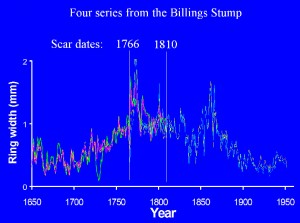
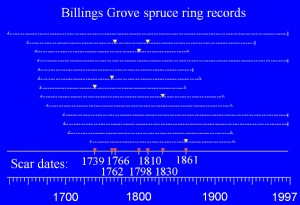
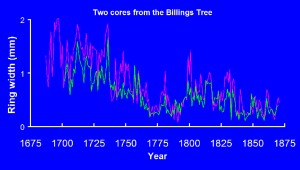
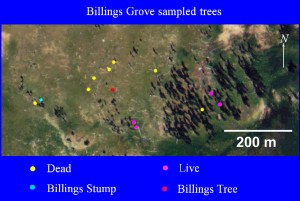
.
Cross-dating the cores of the Billings Tree indicates that it died in about 1873, a time not recorded in any of the fire scars we found. There is not much evidence from outer ring dates that many of the dead trees we sampled died synchronously, for example in a fire. But there does appear to be some synchrony of tree initiation in the 1660s. That is the only evidence we found of a widespread stand initiation event. The Billings Tree may be a member of this cohort.
We were all very puzzled by the lack of synchrony among scar dates. The scars were generally convincing “cat face” scars typical of damage by surface fires. I guess it is possible that some of them were caused by bears or porcupines or falling trees. Humans seem like an unlikely agent. If they are indeed fire scars, I assume individual lightning strikes causing small fires is as good an explanation as any.
I’m rather glad that we don’t really know the answer. I like the idea that the University of Wyoming has been right down the road for 125 years, and Libby Flats still offers a challenge to those who think they understand how mountain landscapes work.
The figure at left has the locations of the trees sampled for this exercise. The current image in Google Earth suggests that the Billings Tree is still standing. Here is a KMZ file with a placemark for the tree.
